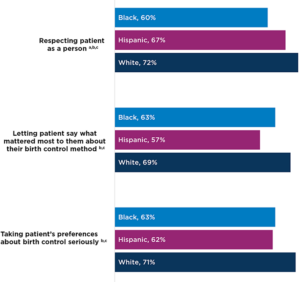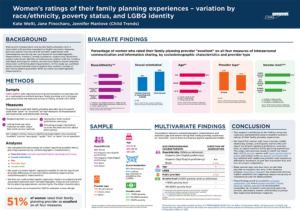Trends in Family Planning Service Provision
A project conducted by Child Trends with funding from the Office of Population Affairs in the U.S. Department of Health and Human Services.
Project Background and Description
Publicly funded family planning centers are a critical source of family planning services in the United States, especially for low-income individuals. Since 2000, the number of U.S. women in need of publicly funded family planning services has risen, but an increasingly lower proportion of this likely need is being met by publicly funded providers. The Title X Family Planning Program, administered by the Office of Population Affairs (OPA), is the only federal program designed specifically to provide comprehensive family planning and related preventive health services to individuals. In 2019 alone, more than 3.1 million family planning clients received care at Title X clinics.
Through a grant from OPA, Child Trends is conducting The Trends in Family Plannng Service Provision Study to help publicly funded family planning providers better meet the health care needs of their clients—particularly the needs of underserved populations, such as racial/ethnic minorities, populations with limited English proficiency, adolescents, and populations in rural areas. Our findings will deepen the field’s understanding of the characteristics and needs of family planning clients, and its understanding of service provision by family planning providers, and will offer insight into innovative practices in the field.
Study Activities
The study is being implemented from 2019 to 2022 and will use both quantitative and qualitative research methods. For the quantitative component, the Child Trends study team is analyzing data from sources such as the National Survey of Family Growth (NSFG), the Family Planning Annual Report (FPAR), and the Survey of U.S. Publicly Funded Family Planning Clinics (Clinic Survey). For the qualitative component, the study team is collecting and analyzing data from in-depth interviews with publicly funded Title X family planning service providers and clients. The study will address, or has addressed, the following topics:
- Client characteristics and current services: Child Trends analyzed NSFG data to understand the sociodemographic characteristics and health needs of Title X family planning clients and published its findings in a research brief. Ongoing analyses will explore the demographic characteristics of rural women as well as their need for and use of family planning services.
- Access to services: Child Trends is currently conducting interviews with family planning clinics and clients to understand the barriers and facilitators to accessing family planning services in rural settings, as well as rural women’s experiences with family planning visits and contraceptive counseling. Ongoing analyses examine providers’ perceptions of the intangible barriers that clients experience to accessing care, such as stigma around family planning and concerns about privacy, and will discuss providers’ strategies to mitigate those barriers.
- Person-centered contraceptive care: Child Trends analyzed NSFG data to examine patients’ ratings of their family planning providers on measures of person-centered care, and how patients’ experiences differ by their sociodemographic characteristics. Results were published in a Child Trends data point and shared as a poster during the National Reproductive Health Conference.
- Innovative service delivery approaches during COVID-19: Child Trends used data from interviews with current and former Title X provider to highlight providers’ adaptations to address client’s needs during the COVID-19 pandemic. Results were published in a Child Trends research brief.
Publications
 Brief: Title X Family Planning Clients Face Economic Challenges and Health Disparities
Brief: Title X Family Planning Clients Face Economic Challenges and Health Disparities
This brief uses data from the National Survey of Family Growth to compare the characteristics of women who receive family planning services from Title X clinics to those of women who receive family planning services from private doctors. We found that the two groups of women have differ by demographics, economic challenges, and health needs. These findings highlight the importance of Title X services for women in need and can help providers better tailor services for their clients.
Brief: How Family Planning Providers Are Addressing Clients’ Reproductive Health Needs During COVID-19
From July 2020 to January 2021, Child Trends conducted interviews with staff from more than 30 current and former Title X clinics to better understand their experiences providing family planning services during the pandemic. This brief describes clinics’ experiences and the adaptations and strategies they adopted to provide family planning services while ensuring the safety of staff and clients, as well as the practices they would like to continue implementing beyond the pandemic.
 Data Point: Two Thirds or Less of Black and Hispanic Women Rate Their Experiences with Family Planning Providers as “Excellent”
Data Point: Two Thirds or Less of Black and Hispanic Women Rate Their Experiences with Family Planning Providers as “Excellent”
This data point analyzes National Survey of Family Growth data on patients’ experiences with their family planning provider and the quality of interpersonal care they received. We found racial and ethnic disparities in the quality of care that patients received, with Black and Hispanic women less likely than White women to give their provider the highest rating on respecting the client as a person, letting the client say what mattered most to them in choosing a contraceptive method, and taking the client’s preferences seriously.
Presentations
 Poster: Women’s ratings of their family planning experiences – variation by race/ethnicity, poverty status, and LGBQ identity
Poster: Women’s ratings of their family planning experiences – variation by race/ethnicity, poverty status, and LGBQ identity
This poster presents differences in patients’ experiences with family planning providers by race/ethnicity, income level, sexual orientation, and age, as well as provider type (public vs. private). Specifically, we assessed how patients rated their provider on measures of interpersonal communication and patient-centeredness. This poster was presented August 10-13, 2021 at the National Reproductive Health Conference.
Slides: Strategies Title X Providers Are Using to Meet Clients’ Family Planning Needs during the COVID-19 Pandemic
This presentation uses findings from interviews with Title X providers to highlight strategies that providers have used to meet clients’ family planning needs during the COVID-19 pandemic. These slides were presented at the virtual Title X Grantee Conference on July 14, 2021.
Project Contacts
Child Trends key contacts
- Jennifer Manlove, PhD | 240-223-9262 | jmanlove@childtrends.org
- Kate Welti, MPP | 202-744-2413 | kwelti@childtrends.org
- Bianca Faccio | 240-223-9256 | bfaccio@childtrends.org
Federal program officer
- Roshni Menon, PhD | 240-453-6175 | roshni.menon@hhs.gov
The project described is supported by Grant Number 1 FPRPA006070-01-00 from the Department of Health and Human Services Office of Population Affairs. Contents are solely the responsibility of the authors and do not necessarily represent the official views of the Department of Health and Human Services or the Office of Population Affairs.
© Copyright 2025 ChildTrendsPrivacy Statement
Newsletter SignupLinkedInYouTubeBlueskyInstagram